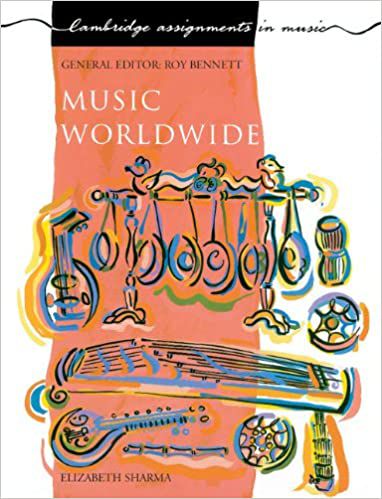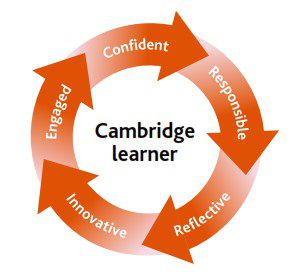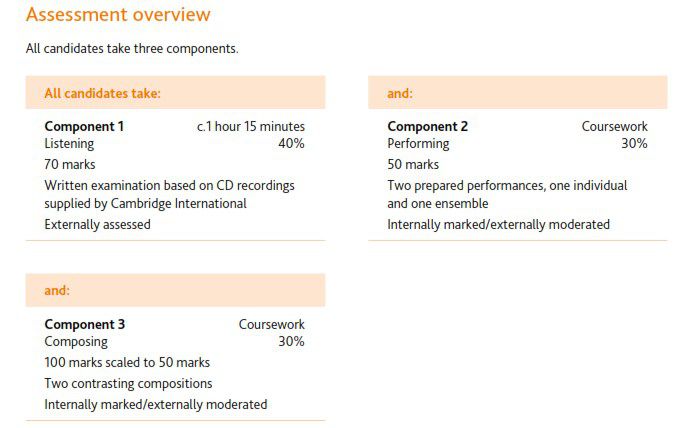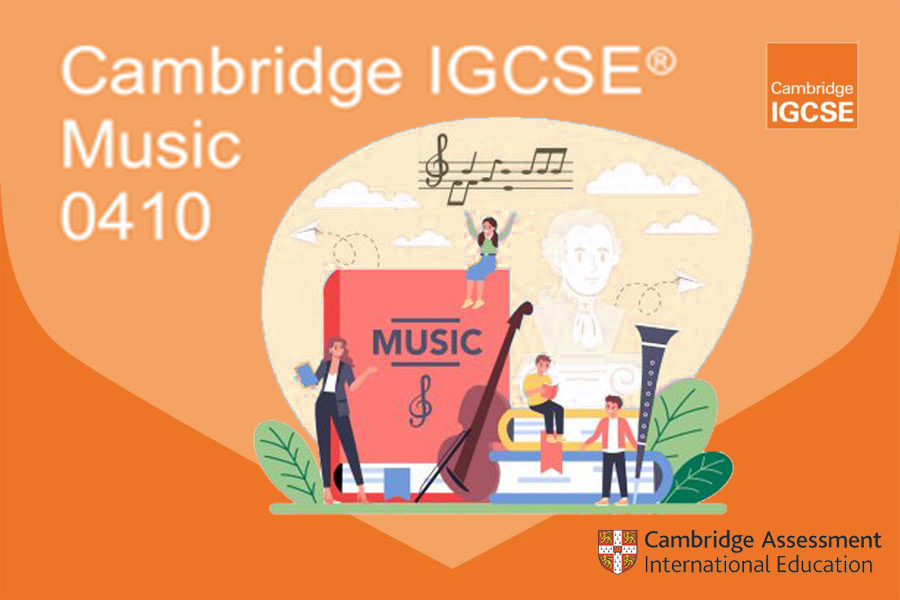COURSES DETAILS
Music-0410 IGCSE
Ариунчимэг Шаарийбуу
IGCSE
Тайлбар
IGCSE-ийн хөгжмийн хичээлийн цаг нь 7
хоногт 80 минутаар 3
удаа ордог.
Assessment
Structure-Үнэлгээний бүтэц:
Сomponent-Listening:
Section A
Section B
Section C
Section D:World Music – Prescribed Focus

•Энэ номонд Латин Америкаас бусад орны хөгжмийн тухай тодорхой байдаг бөгөөд мөн интернет, youtube-ээс ч гарын авлагатай болж болно.
Section D: Western Set Work
2020 оны шалгалтанд:
Сонгогдсон зохиол
эсвэл
2021оны шалгалтанд:
Сонгогдсон зохиол
эсвэл
2022 оны шалгалтанд:
Сонгогдсон зохиол
эсвэл
Component 2: Performing /Хөгжимдөх эсвэл дуулах/
Component 3: Composing / Хөгжим зохиох/
Our programs balance a thorough knowledge and understanding of a subject and help to develop the skills
learners need for their next steps in education or employment.
Our approach encourages learners to be:

All candidates take three components.
The subject content described here is the content of Component 1 Listening.
Listening:
Rudiments:
Standard staff notation including dynamic, tempo, and expression markings, simple ornaments and articulation signs, treble, bass, and alto clefs, key signatures up to 4 sharps and 4 flats in major and minor keys, time signatures, major, minor and perfect intervals. Melody and rhythm:
Major, minor, chromatic, whole-tone, and pentatonic scales. Blue notes. Melodic movement (ascending or descending by step or leap). Phrasing. Call and response. Duple, triple, or irregular meter. Syncopation, swing, polyrhythm.
Harmony
Primary chords: I, IV, and V (7); secondary chords: II and VI. Perfect, imperfect, and interrupted cadences. Modulations to related keys (sub-dominant, dominant, relative minor, relative major).
Ensembles and instruments/voices
Western ensembles and instruments: orchestras, jazz bands, choirs, and chamber music ensembles. The main instruments and voices used in the above ensembles.
Keyboard instruments: piano, harpsichord, organ.
World ensembles and instruments:
Indonesian: gamelan;
African and Arab: Raba Indian: bansuri, sitar, Sa – rangı, kora, xylophone, ’ud, tabla;
Chinese: Ch'in, dizi, erh-hu;
Japanese: shakuhachi, koto, sho
Latin American: bandoneon, pan-pipes, charangos, guitars.
Instrumental and/or vocal effects
Arco, pizzicato, glissando, tremolo, double-stopping, strumming, pitch bending, mute, roll, melisma.
Structure
Binary, ternary, rondo, theme and variations, ground bass. Compositional devices Repetition, imitation, sequence, canon, ostinato, drone, Alberti bass, pedal (tonic and dominant), contrary motion.
Texture
Melody and accompaniment, homophonic, polyphonic, monophonic, heterophonic, parallel motion.
Style
Baroque, Classical, Romantic, Twentieth Century (including impressionism, neo-classicism, jazz, minimalism).
Genre
Opera, oratorio (including recitative, aria, and chorus), musical, symphony, concerto, string quartet, sonata, march, waltz, minuet, and trio.
Performing
Internally marked/externally moderated coursework, 50 marks
Component 2 consists of prepared performances of the candidate’s own choice, all of which must be recorded.
Candidates must:
(i) sing or play individually – either one piece or two short contrasting pieces (which should be on the same
instrument) and
(ii) sing or play in an ensemble – either one piece or two short contrasting pieces (which should be on the same
instrument – but this does not need to be the same instrument as that offered for individual performing).
The total playing time should be between 4 and 10 minutes.
The music performed should be appropriate, in its technical and musical demands, to the candidate’s stage of
development at the time of the examination. Positive credit is given for the following:
(a) the range of technical and musical skills demonstrated
(b) accuracy of playing the notes and rhythm (in notated music) OR quality of improvisation (in music that is not notated)
(c) choice and control of tempo (in an individual performance) OR ensemble coordination (in an ensemble performance)
(d) sensitivity to phrasing and expression
(e) technical control of the instrument.
Composing
Candidates submit two compositions, written for different instruments and/or voices, which must be recorded.
Composition 1 must be written in a Western, tonal style and must demonstrate familiarity with the basic principles
of traditional harmonic language; this composition must be fully notated using staff notation and the score must
be submitted with the recording. Composition 2 may be in any style of the candidate’s choice and may be notated in whatever form of notation is appropriate to the music. If staff notation is not used, the intentions of the notation must be clearly explained in an
accompanying commentary. The score and commentary (if applicable) must be submitted with the recording.
The notation may be either handwritten or computer-generated, but all scores must be accurately edited. If notations
other than staff notation are submitted, they must be accurately designed to show the duration of the sounds
represented by whatever symbols are used (e.g. guitar chord symbols on their own do not show duration).
Alternative notation should not be used for any piece which is capable of being notated in staff notation.
Teachers must certify that the compositions are the individual work of the candidate who claims authorship.
Candidates will be given positive credit for:
(a) their ideas
(b) the structure of their compositions
(c) their use of the chosen medium
(d) compositional technique
(e) score presentation/notation.
Course Content
| Classical Music Revision |
| Baroque Music Revision |
PRICE
Үнэгүй

Language:
English
Lectures:
2
Total Duration:
07:04
Level:
Beginner
